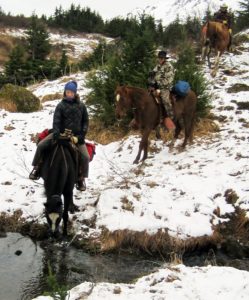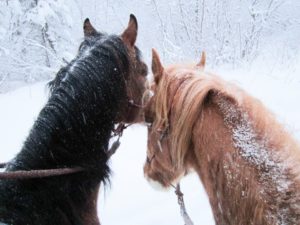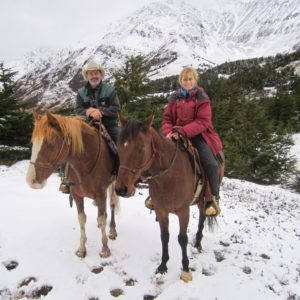Horseback in Winter
Bareback and bunny boots are secrets to staying warm
Light snow falls like a whisper, settling softly on the black mane of my horse. In the crisp air of winter, he snorts and paws at the snow-covered trail. He is as eager to go as I am. There’s no better way to explore the soul of the wilderness than from the saddle. Winter or summer, the discovery of what’s around the next bend is made richer by the easy companionship of a good horse.
That said, winter riding poses some challenges. Riders need to stay warm and horses need to stay cool. Horses adapt well to Alaska’s winter by growing thick, luxurious coats, and they can overheat. On the other hand, horseback riding in winter can be cold for riders. I’ve asked friends who ride about the lowest temperature they will venture out on horseback. For Laurie Knuutila of Fairbanks, she says she used to ride regularly at 20 below.
“The older I get though, the warmer the threshold,” she laughs. “I’m at about 20 above these days.” Knuutila has owned horses for 39 of her 40 years in Alaska.
For my husband and me in Southcentral Alaska, we often stave off the cold by riding bareback, in close contact with a warm horse. Vapor-barrier “bunny boots” are ideal for keeping toes toasty. The bulbous rubberized footwear was originally designed by the military for use in extreme cold weather. When we do saddle up, we have extra-wide stirrups to fit those big boots. Hiking alongside our horses is another great way to warm up.
Chugach State Park
Alaska’s Governor Bill Egan rode a horse to the dedication ceremony of Chugach State Park at the Glenn Alps trailhead in Anchorage in 1970. From the construction of railroads and telegraph lines to packing supplies in to miners, Alaska could not have been settled without equine horse-power.
“It’s a great way to see some of the best areas of the park,” according to Ranger Tom Crockett. There are some restrictions, however, and he suggests getting on the Alaska Department of Natural Resources website (dnr.alaska.gov) to learn which trails and seasons are open to horse travel.
Eklutna Lake
We once took a moonlight ride along Eklutna’s Lakeside Trail. The temperature was well below, zero but the stars were bright and the moon cast long shadows on the snow. Cold frosted the inside of our noses, and the horses’ breath crystallized on their eyelashes. The wide trail goes 12.9 miles one-way but we rode for only an hour or two. Long stretches of glaciated ice across the trail eventually turned us back. Our horses have ice shoes, much like studded snow-tires. They are sure-footed in some amazing winter conditions, but we didn’t press our luck. Another winter challenge is the short daylight hours. Our Eklutna ride proved that moonlight can be as enjoyable for riding as sunlight.
Indian Valley
We traveled this challenging trail early one winter when the ground was frozen but the snow wasn’t too deep for passage. The trail crosses Indian Creek several times through an old-growth forest as it winds up the hillside along Turnagain Arm. The trail is steep in places with 2,100-foot elevation gain along the 6.3 miles up to Indian Creek Pass. This is a well-traveled ski trail once the snow is deep enough, and good trail etiquette means being considerate of other trail users—i.e. not post-holing through soft trail conditions.
Peters Creek Valley is our weekend go-to since we live just minutes from the trailhead. An old roadbed at the start offers five miles of gently sloped trails that are usually wide enough to ride two abreast. The roadbed ends at an open area that was once the site of an old homestead with views of Mount Eklutna. A short embankment slopes down to Four-Mile Creek, and a spur trail connects with the rest of the 14-mile Peters Creek Valley trail. It’s not uncommon to see moose anywhere horses can go in Alaska. Same goes for bears—and we’ve encountered many. One advantage to winter riding is that bears are mostly napping.
Matanuska Greenbelt Trails
These remain some of our favorite trails year-round. With more than 3,000 acres and miles of winding paths, this network of trails crosses Matanuska-Susitna Borough, University of Alaska, and State Recreation Area lands. Smooth lakes dot the terrain and soaring views of Pioneer Peak can be seen from snow-covered hay fields. The adjoining forested trails are home to moose, raven, snowshoe hare, spruce hen, and the occasional fox. Stories of the comings and goings of these creatures are written in the tracks on the snow.
The subtleties of winter are made even more remarkable from the back of an honest horse. The way of the horse is to perceive fully every nuance of their environment. They are attentive to every turn of leaf and shadow, all of which are measured and considered with quiet regard. We would all do well to see the world in such a deliberate way.
Published in November 2016 Alaska magazine.

